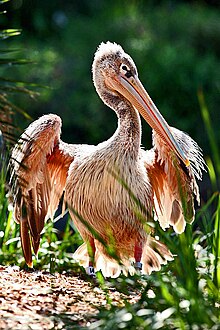Pink-backed pelican
| Pink-backed pelican | |
|---|---|

| |
| Scientific classification | |
| Kingdom: | |
| Phylum: | |
| Class: | |
| Order: | |
| Family: | |
| Genus: | |
| Species: | P. rufescens
|
| Binomial name | |
| Pelecanus rufescens Gmelin, 1789
| |
The pink-backed pelican (Pelecanus rufescens) is a bird of the pelican family. It is a resident breeder in swamps and shallow lakes of Africa, southern Arabia, southern India and is apparently extirpated in Madagascar.
Description
This is a relatively small pelican though by no means a small bird. Length is from 125 to 155 cm (49 to 61 in), wingspan is 2.15–2.9 m (7.1–9.5 ft) and body mass if from 4 to 7 kg (8.8 to 15.4 lb). The bill is 30 to 38 cm (12 to 15 in) in length.[2][3] The plumage is grey and white, with a pinkish hue on the back occasionally apparent (never in the deep pink of a flamingo). The top of the bill is yellow and the pouch is usually greyish. Breeding adults have long feather plumes on the head.
It shares habitat with the great white pelican which is generally larger and has white instead of greyish plumage.
Habitat and breeding
The pink-backed pelican is found in a range of aquatic habitats, but prefers quiet backwaters with shallow water, avoiding steep, vegetated lake banks. It prefers for freshwater lakes, swamps, large slow-flowing rivers, and seasonal pools but also frequents reservoirs, seasonally flooded land and flood-plains near river mouths. It may occur on alkaline and saline lakes and lagoons, and can sometimes be found along the coast in bays and estuaries (although seldom on open seashore). The species tends to roost and breed in trees (e.g. mangroves), but will also roost on sandy islands, cliffs, coral reefs and sand-dunes.
Nesting trees have many nests built close together. These nests are re-used every year until the trees collapse, although the birds will normally remain in the area. The species nests colonially in trees, reeds or low bushes along waterfronts as well as (less often) on the ground on sandy islands and in mangroves.
The nest is a large heap of sticks and may be 10–50 m above the ground. The female lays two to three large white eggs and later the chicks feed by plunging their heads deep into the adult’s pouch and taking the partially digested regurgitated fish.
Diet
Food is usually fish (of any size up to 450 g, usually in the 80-290 g range) and amphibians, and is usually obtained by fishing in groups. Among the fish preyed upon are cichlids like Haplochromis and Tilapia.

